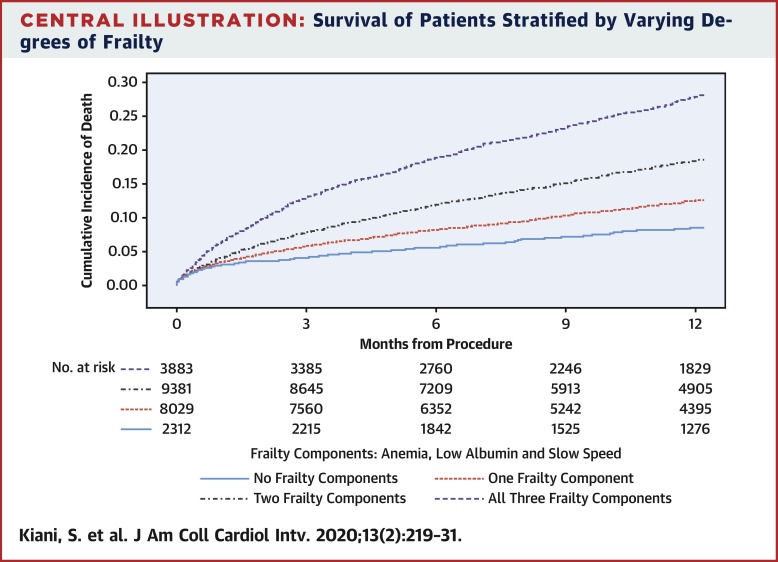当前位置:
X-MOL 学术
›
JACC Cardiovasc. Inte.
›
论文详情
Our official English website, www.x-mol.net, welcomes your
feedback! (Note: you will need to create a separate account there.)
The Effect and Relationship of Frailty Indices on Survival After Transcatheter Aortic Valve Replacement.
JACC: Cardiovascular Interventions ( IF 11.7 ) Pub Date : 2020-01-27 , DOI: 10.1016/j.jcin.2019.08.015 Soroosh Kiani 1 , Amanda Stebbins 2 , Vinod H Thourani 3 , Jessica Forcillo 4 , Sreekanth Vemulapalli 2 , Andrzej S Kosinski 2 , Vasilis Babaliaros 1 , David Cohen 5 , Susheel K Kodali 6 , Ajay J Kirtane 6 , James B Hermiller 7 , James Stewart 1 , Angela Lowenstern 2 , Michael J Mack 8 , Robert A Guyton 9 , Chandan Devireddy 1 ,
JACC: Cardiovascular Interventions ( IF 11.7 ) Pub Date : 2020-01-27 , DOI: 10.1016/j.jcin.2019.08.015 Soroosh Kiani 1 , Amanda Stebbins 2 , Vinod H Thourani 3 , Jessica Forcillo 4 , Sreekanth Vemulapalli 2 , Andrzej S Kosinski 2 , Vasilis Babaliaros 1 , David Cohen 5 , Susheel K Kodali 6 , Ajay J Kirtane 6 , James B Hermiller 7 , James Stewart 1 , Angela Lowenstern 2 , Michael J Mack 8 , Robert A Guyton 9 , Chandan Devireddy 1 ,
Affiliation

|
OBJECTIVES
This study sought to evaluate the ability of individual markers of frailty to predict outcomes after transcatheter aortic valve replacement (TAVR) and of their discriminatory value in different age groups.
BACKGROUND
Appropriate patient selection for TAVR remains a dilemma, especially among the most elderly and potentially frail.
METHODS
The study evaluated patients ≥65 years of age in the Society of Thoracic Surgeons/American College of Cardiology Transcatheter Valve Therapy registry, linked to Centers for Medicare and Medicaid administrative claims data, receiving elective TAVR from November 2011 to June 2016 (n = 36,242). Indices of frailty included anemia, albumin level, and 5-m walk speed. We performed Cox proportional hazards regression for 30-day and 1-year mortality, adjusting for risk factors known to be predictive of 30-day mortality in the Transcatheter Valve Therapy registry, as well as survival analysis.
RESULTS
These indices are independently associated with mortality at 30 days and 1 year and provide incremental value in risk stratification for mortality, with low albumin providing the largest value (hazard ratio: 1.52). Those with low albumin and slower walking speed had longer lengths of stay and higher rates of bleeding and readmission (p < 0.001). Those with anemia also had higher rates of bleeding, readmission, and subsequent myocardial infarction (p < 0.001).
CONCLUSIONS
This represents the largest study to date of the role of frailty indices after TAVR, further facilitating robust modeling and adjusting for a large number of confounders. These simple indices are easily attainable, and clinically relevant markers of frailty that may meaningfully stratify patients at risk for mortality after TAVR.
中文翻译:

脆弱指数对经导管主动脉瓣置换后存活率的影响及其关系。
目的本研究旨在评估体弱的单个标志物预测经导管主动脉瓣置换术(TAVR)后结果的能力及其在不同年龄组的区分价值。背景技术对于TAVR的适当患者选择仍然是一个难题,尤其是在最年长且可能脆弱的人群中。方法该研究评估了2011年11月至2016年6月接受选择性TAVR治疗的胸外科医师协会/美国心脏病学会经导管瓣膜治疗注册中心≥65岁的患者,该注册中心与Medicare和Medicaid中心的行政要求数据相关联(n = 36,242) )。虚弱的指标包括贫血,白蛋白水平和5 m步行速度。我们针对30天和1年的死亡率进行了Cox比例风险回归,调整经导管瓣膜治疗注册表中已知可预测30天死亡率的危险因素以及生存分析。结果这些指标与30天和1年时的死亡率独立相关,并为死亡率的风险分层提供增量值,而低白蛋白的值最大(危险比:1.52)。白蛋白含量低且步行速度较慢的患者住院时间更长,出血和再入院率更高(p <0.001)。贫血患者的出血,再入院率和随后的心肌梗塞发生率也更高(p <0.001)。结论这是迄今为止TAVR之后脆弱指数作用的最大的研究,进一步促进了健壮的建模和针对大量混杂因素的调整。这些简单的指标很容易实现,
更新日期:2020-01-21
中文翻译:

脆弱指数对经导管主动脉瓣置换后存活率的影响及其关系。
目的本研究旨在评估体弱的单个标志物预测经导管主动脉瓣置换术(TAVR)后结果的能力及其在不同年龄组的区分价值。背景技术对于TAVR的适当患者选择仍然是一个难题,尤其是在最年长且可能脆弱的人群中。方法该研究评估了2011年11月至2016年6月接受选择性TAVR治疗的胸外科医师协会/美国心脏病学会经导管瓣膜治疗注册中心≥65岁的患者,该注册中心与Medicare和Medicaid中心的行政要求数据相关联(n = 36,242) )。虚弱的指标包括贫血,白蛋白水平和5 m步行速度。我们针对30天和1年的死亡率进行了Cox比例风险回归,调整经导管瓣膜治疗注册表中已知可预测30天死亡率的危险因素以及生存分析。结果这些指标与30天和1年时的死亡率独立相关,并为死亡率的风险分层提供增量值,而低白蛋白的值最大(危险比:1.52)。白蛋白含量低且步行速度较慢的患者住院时间更长,出血和再入院率更高(p <0.001)。贫血患者的出血,再入院率和随后的心肌梗塞发生率也更高(p <0.001)。结论这是迄今为止TAVR之后脆弱指数作用的最大的研究,进一步促进了健壮的建模和针对大量混杂因素的调整。这些简单的指标很容易实现,











































 京公网安备 11010802027423号
京公网安备 11010802027423号